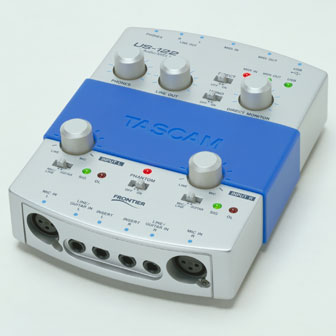![]()
I’m finding it hard to concentrate
too busy thinking to think
feeling more stirred than shaken
but still feeling like a drink
![]()
I’m finding it hard to concentrate
too busy thinking to think
feeling more stirred than shaken
but still feeling like a drink
Whilst browsing on Amazon for some old CDs I had lost back in college, I came across a video called “Getting Physical.”:http://www.amazon.com/exec/obidos/tg/detail/-/6301801482/qid=1075322041/sr=1-7/ref=sr_1_7/103-2331412-6519822?v=glance&s=video The reason I bring it up is the first review for Getting Physical is kind of disturbing.
Yesterday, I received the first peice in my home recording puzzle, the Tascam US-122 USB Audio/MIDI Interface ($185 new on ebay shipped). This thing is bigger than I thought it was going to be but I was expecting a cheap little plastic USB Device… Not so. The first thing I noticed about the Tascam US-122 is that it’s a substantial piece of audio equipment, the solid steel construction of the 2 pound interface sits firmly on your desktop, without many fears that a coiled mic cable will flip it over.

Tascam US-122 features:
Installation of the drivers needed was a breeze, I decided to download drivers directly from the Tascam website instead of messing with the included installation CD. A restart later the US-122 was up and running. In GarageBand’s Preferences, selecting Audio/MIDI was equally easy to start recording from my guitars pickup. Although at first I noticed an audio lag from what I was playing when I was monitoring the guitar track, I quickly found opening the included utility US-122 Manager I could set the Audio Safety Buffer from 2ms to 1ms and the lag disappeared.
The sound quality, recording directly from my Takamine EG330SC acoustic guitar, was very clear and synched to my playing, although I could detect a slight latency. Unfortunately latency, or audio lag, is a problem on all USB recording devices and the Tascam US-122 is susceptible, but Tascam includes a zero latency direct monitoring feature which allows you to bypass the circuitry and listen to your input directly. The latency was almost imperceptible with all track effects off in GarageBand.
I had never heard my guitar accept through cheap guitar amps and the US-122 was so clear and detailed that I could hear every movement of my fingers on the strings and every missed fret. It was a little unnerving. The short of it is, the Tascam US-122 is extremely responsive, so much so you may be surprised to hear your guitar uncolored.
( Here’s a sample from my horrible playing. MP3 340k )
To my Takamine’s defense, I really didn’t have a chance to fool around with any settings and the recording is done straight, without any EQ adjustments. It will be interested to see what I can do to make the guitar sound like I want it to… fingers crossed.
UPDATE: Sat down for half an hour with my acoustic guitar and went through GarageBand’s settings. This is more like it. Forgive Me Love instrumental as QuickTime Movie 450kb.
(To be added later this week, dynamic microphones and the Tascam US-122)
You know you’ve ordered too much Chinese food for yourself, when you get two fortune cookies.
Just to clarify things, putting together a home studio is my first attempt at any musical recording outside of recoding on a hand held tape recorder, I am not a professional. The way I’m approaching it is to look at my influences, see how they recorded, and try to reproduce it in my budget and using the latest technology. This my list and shouldn’t been seen as a guide. I am writing this both to record to myself as well as help others in my position of wanting to record music, but not knowing how to go about doing it. I set up this list of things I must remember when setting up a home studio, acquired from different books and online articles.
To start with I needed an audio recording and mixing device. Back in the days it would have been a huge reel-to-reel recorders with huge mixing boards and teams of engineers in lab coats pushing little light up buttons. In the professional world today they use huge digital recorders and mixing decks, behind glass with millions of dollars of equipment. In an amateur home recording studio there are many different approaches from analog tape mixers, digital deck mixers, to computer based recoding. I chose to edit on my old Apple laptop using software which takes up the least space and allows for maximum quality and maximum edit-ability over all the other amateur formats, for this I am using a PowerBook and a copy of GarageBand to record and mix. GarageBand also has virtual amps which utilize DI (Direct Inject) which sound great, cost a fraction of real amps, are post-production friendly (can change amp’s sound later in the mix) and save a huge amount of my limited urban living space.
(Direct Injecting is a recording term used when you don’t mic up a guitar’s amp, but rather plug the guitar directly into the mixing board. It is often seen by professionals as cheating because it does not allow for an artist’s individual amplifier sound to be captured, but then again the same was said about digital photography 5 years ago.)